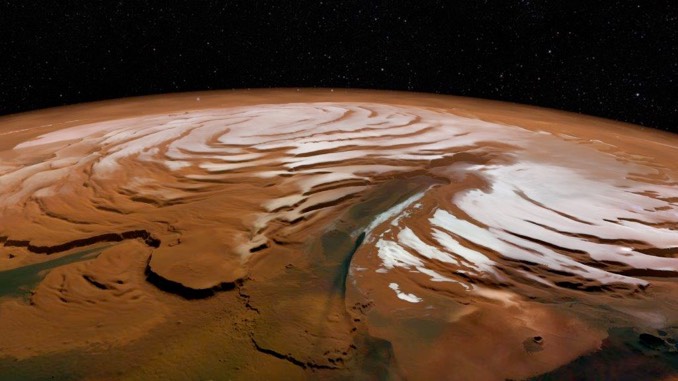
Scientists have discovered remnants of ancient ice sheets buried in sand a mile beneath Mars’s north pole, they report in a new study. The findings show conclusive evidence of the waxing and waning of polar ice on the red planet due to changes in its orbit and tilt, according to the study’s authors.
Researchers at the University of Texas at Austin and the University of Arizona made the discovery using measurements gathered by the Shallow Radar (SHARAD) instrument on NASA’s Mars Reconnaissance Orbiter. SHARAD emits radar waves that can penetrate up to a mile and a half beneath Mars’s surface.
The new findings, published today in AGU’s journal Geophysical Research Letters, are important because the layers of ice are a record of past climate on Mars in much the same way that tree rings are a record of past climate on Earth, according to the researchers. Studying the geometry and composition of these layers could tell scientists whether climate conditions were previously favourable for life.
The team found layers of sand and ice that were as much as 90 percent water in some places. If melted, the newly discovered ice would be equivalent to a global layer of water around Mars at least 1.5 meters (5 feet) deep, which could be one of the largest water reservoirs on the planet, according to the researchers.
“We didn’t expect to find this much water ice here,” said Stefano Nerozzi, a graduate research assistant at the University of Texas Institute for Geophysics (UTIG) and lead author of the new study. “That likely makes it the third largest water reservoir on Mars after the polar ice caps.”

The findings were corroborated by an independent study using gravity data instead of radar, led by researchers at Johns Hopkins University and also published today in Geophysical Research Letters, of which Nerozzi is a co-author.
The authors suspect the layers formed when ice accumulated at the poles during past ice ages on Mars. Each time the planet warmed, a remnant of the ice caps became covered by sand, which protected the ice from solar radiation and prevented it from dissipating into the atmosphere.
Scientists have long known about glacial events on Mars, which are driven by variations in the planet’s orbit and tilt. Over periods of about 50,000 years, Mars leans toward the sun before gradually returning to an upright position, like a wobbling spinning top. When the planet spins upright, the equator faces the sun, allowing the polar ice caps to grow. As the planet tilts, the ice caps retreat, perhaps vanishing entirely.
Until now, scientists thought the ancient ice caps were lost. The new findings show that in fact significant ice sheet remnants have survived under the planet’s surface, trapped in alternating bands of ice and sand, like layers on a cake.



